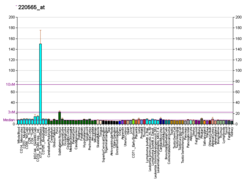CCR10
| CCR10 | |||||||
|---|---|---|---|---|---|---|---|
| Identifiers | |||||||
| Aliases | CCR10, GPR2, C-C motif chemokine receptor 10 | ||||||
| External IDs | MGI: 1096320 HomoloGene: 7271 GeneCards: CCR10 | ||||||
| RNA expression pattern | |||||||
 |
|||||||
| More reference expression data | |||||||
| Orthologs | |||||||
| Species | Human | Mouse | |||||
| Entrez |
|
|
|||||
| Ensembl |
|
|
|||||
| UniProt |
|
|
|||||
| RefSeq (mRNA) |
|
|
|||||
| RefSeq (protein) |
|
|
|||||
| Location (UCSC) | Chr 17: 42.68 – 42.68 Mb | Chr 11: 101.17 – 101.18 Mb | |||||
| PubMed search | |||||||
|
|
|||||||
C-C chemokine receptor type 10 is a protein that in humans is encoded by the CCR10 gene.
Chemokines are a group of small (approximately 8 to 14 kD), mostly basic, structurally related molecules that regulate cell trafficking of various types of leukocytes through interactions with a subset of 7-transmembrane, G protein-coupled receptors. Chemokines also play fundamental roles in the development, homeostasis, and function of the immune system, and they have effects on cells of the central nervous system as well as on endothelial cells involved in angiogenesis or angiostasis. Chemokines are divided into 2 major subfamilies, CXC and CC, based on the arrangement of the first 2 of the 4 conserved cysteine residues; the 2 cysteines are separated by a single amino acid in CXC chemokines and are adjacent in CC chemokines.
...
Wikipedia
